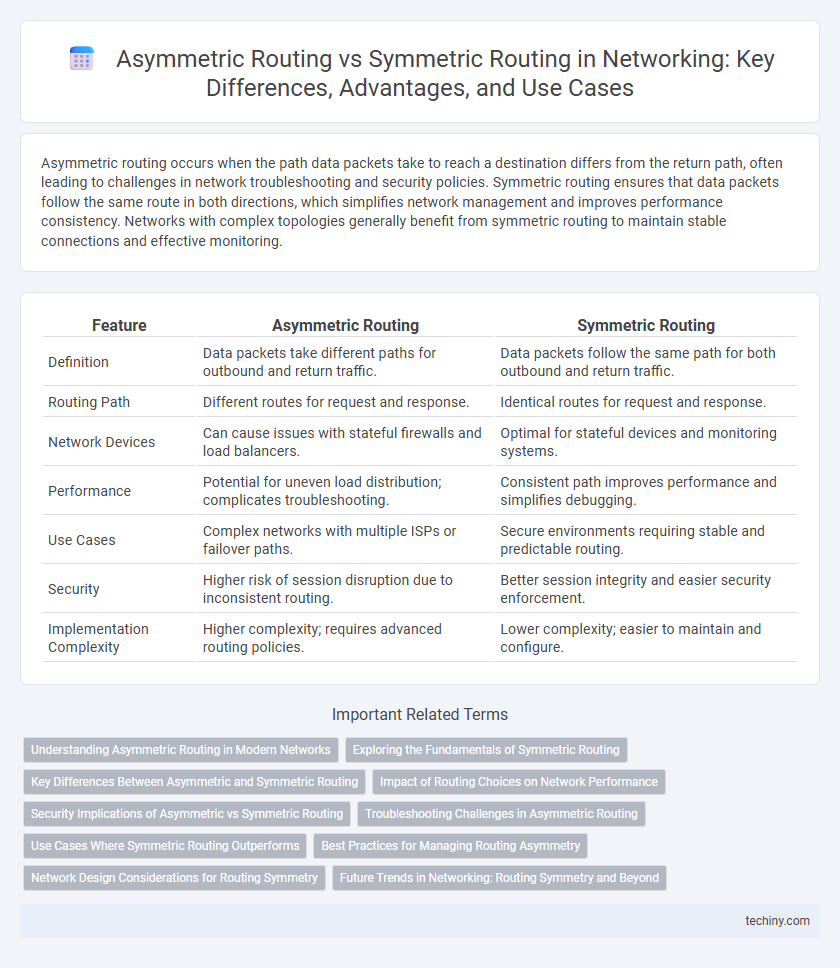Asymmetric routing occurs when the path data packets take to reach a destination differs from the return path, often leading to challenges in network troubleshooting and security policies. Symmetric routing ensures that data packets follow the same route in both directions, which simplifies network management and improves performance consistency. Networks with complex topologies generally benefit from symmetric routing to maintain stable connections and effective monitoring.
Table of Comparison
| Feature | Asymmetric Routing | Symmetric Routing |
|---|---|---|
| Definition | Data packets take different paths for outbound and return traffic. | Data packets follow the same path for both outbound and return traffic. |
| Routing Path | Different routes for request and response. | Identical routes for request and response. |
| Network Devices | Can cause issues with stateful firewalls and load balancers. | Optimal for stateful devices and monitoring systems. |
| Performance | Potential for uneven load distribution; complicates troubleshooting. | Consistent path improves performance and simplifies debugging. |
| Use Cases | Complex networks with multiple ISPs or failover paths. | Secure environments requiring stable and predictable routing. |
| Security | Higher risk of session disruption due to inconsistent routing. | Better session integrity and easier security enforcement. |
| Implementation Complexity | Higher complexity; requires advanced routing policies. | Lower complexity; easier to maintain and configure. |
Understanding Asymmetric Routing in Modern Networks
Asymmetric routing occurs when data packets between two endpoints travel through different paths in each direction, often caused by load balancing or policy-based routing. This routing behavior can lead to challenges in troubleshooting, security, and network performance due to inconsistent path characteristics and stateful inspection issues. Understanding asymmetric routing is crucial for designing resilient modern networks that utilize multiple links and diverse routing protocols.
Exploring the Fundamentals of Symmetric Routing
Symmetric routing occurs when network packets follow the identical path for both outbound and inbound traffic, ensuring consistent route paths between source and destination. This routing method simplifies network troubleshooting and improves security policies by maintaining predictable traffic flows. Its fundamental role in load balancing and firewall state tracking enhances overall network efficiency and reliability.
Key Differences Between Asymmetric and Symmetric Routing
Asymmetric routing occurs when data packets take different paths to and from a destination, while symmetric routing uses the same path in both directions, optimizing performance and simplifying network troubleshooting. Asymmetric routing can introduce challenges such as increased latency, potential security risks, and complications with stateful firewalling or load balancing. Symmetric routing enhances network stability and consistency, reducing routing complexity and ensuring reliable traffic flow in environments like data centers and enterprise networks.
Impact of Routing Choices on Network Performance
Asymmetric routing can lead to increased latency and packet loss due to inconsistent paths between source and destination, complicating troubleshooting and load balancing. Symmetric routing, by maintaining the same route for forward and return traffic, enhances predictability, reduces jitter, and improves overall network stability. Network performance is directly influenced by these routing choices, with predictable symmetric paths supporting more efficient QoS implementations and better utilization of network resources.
Security Implications of Asymmetric vs Symmetric Routing
Asymmetric routing poses significant security challenges by complicating traffic monitoring and intrusion detection, as packets follow different paths for outgoing and incoming traffic, making it harder to correlate sessions. Symmetric routing enhances security visibility by ensuring that inbound and outbound packets traverse the same network path, facilitating consistent firewall policies and simplifying anomaly detection. Network administrators must carefully consider routing symmetry to maintain effective security controls and prevent evasion of intrusion detection systems.
Troubleshooting Challenges in Asymmetric Routing
Asymmetric routing complicates network troubleshooting due to inconsistent traffic paths between source and destination, making it difficult to trace packets and correlate logs. This routing behavior often leads to mismatched firewall states and confusing monitoring data, which hinders accurate detection of packet loss and latency issues. Tools like packet captures and flow analysis require careful configuration to manage the disjointed traffic flows inherent in asymmetric routing environments.
Use Cases Where Symmetric Routing Outperforms
Symmetric routing is essential in security-sensitive environments where firewalls and intrusion detection systems require the same traffic path for request and response to function correctly. Enterprise VPNs and load-balanced data centers benefit from symmetric routing by ensuring consistent session persistence and minimizing latency. Symmetric routing also improves troubleshooting and monitoring accuracy by maintaining path predictability within complex network topologies.
Best Practices for Managing Routing Asymmetry
To manage routing asymmetry effectively, ensure consistent path monitoring using tools like traceroute and network flow analyzers to identify discrepancies. Implement route filtering and access control lists (ACLs) to maintain predictable route paths and reduce security risks associated with asymmetric routes. Prioritize stable BGP route policies and use equal-cost multi-path (ECMP) routing where possible to balance traffic and enhance path symmetry.
Network Design Considerations for Routing Symmetry
Network design considerations for routing symmetry emphasize the importance of path consistency to enhance performance, security, and troubleshooting simplicity. Symmetric routing ensures packets follow the same path in both directions, reducing latency and minimizing issues with stateful firewalls and load balancers. Asymmetric routing, while sometimes necessary for redundancy or policy reasons, can complicate traffic analysis and impact the efficiency of network monitoring tools.
Future Trends in Networking: Routing Symmetry and Beyond
Future trends in networking will emphasize the evolution from traditional symmetric routing towards more adaptive asymmetric routing solutions that optimize traffic flow and enhance network resilience. Advances in machine learning and software-defined networking (SDN) enable dynamic path selection based on real-time network conditions, improving performance and reducing latency. Integration of segment routing and intent-based networking further supports flexible routing strategies, paving the way for intelligent and context-aware network infrastructures.
asymmetric routing vs symmetric routing Infographic

 techiny.com
techiny.com